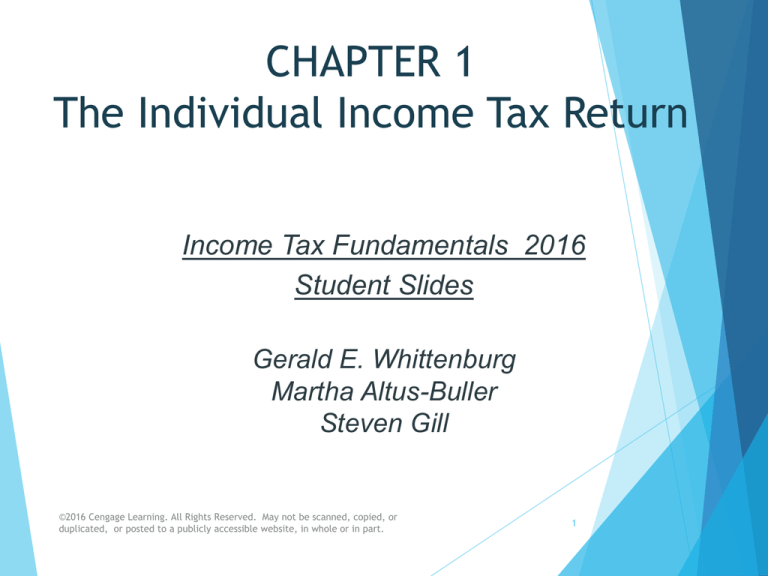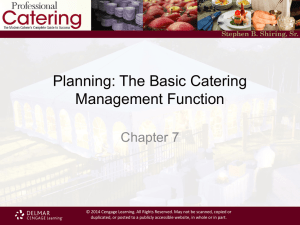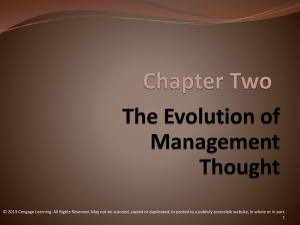
CHAPTER 1
The Individual Income Tax Return
Income Tax Fundamentals 2016
Student Slides
Gerald E. Whittenburg
Martha Altus-Buller
Steven Gill
©2016 Cengage Learning. All Rights Reserved. May not be scanned, copied, or
duplicated, or posted to a publicly accessible website, in whole or in part.
1
History of Taxation
Since 1913, when 16th amendment was passed,
the constitutionality of income tax has never been
questioned by federal courts
Income taxes serve a multitude of purposes
©2016 Cengage Learning. All Rights Reserved. May not be scanned, copied, or
duplicated, or posted to a publicly accessible website, in whole or in part.
2
Objectives of Tax Law
Raise revenue
Tool for social and economic policies
o
o
o
Social policy encourages desirable activities and discourages
undesirable activities
Deductions for charitable contributions
Credits for higher education expenses
Credits for taxpayers in disaster areas
Economic policy as manifested by fiscal policy
Encourage investment in capital assets through depreciation
Credits for investment in solar and wind energy
Both economic and social
Exclude gain on sale of personal residence up to $250,000 ($500,000 if
married)
©2016 Cengage Learning. All Rights Reserved. May not be scanned, copied, or
duplicated, or posted to a publicly accessible website, in whole or in part.
3
Primary Entities/Forms
Individual
o
Taxable income includes wages, salary, selfemployment earnings, rent, interest and dividends
o
An individual may file simplest tax form qualified for
1040EZ
1040A
1040
o
If error made on one of the three above forms, can
amend with a 1040X
©2016 Cengage Learning. All Rights Reserved. May not be scanned, copied, or
duplicated, or posted to a publicly accessible website, in whole or in part.
4
Tax Formula for Individuals
This formula follows Form 1040
Gross Income
less:
Deductions for Adjusted Gross Income (AGI)
AGI
less:
Greater of Itemized or Standard Deduction
less:
Exemption(s)
Taxable Income (TI)
times: Tax Rate (using tax tables or rate schedules)
Gross Tax Liability
less:
Tax Credits and Prepayments
Tax Due or Refund
©2016 Cengage Learning. All Rights Reserved. May not be scanned, copied, or
duplicated, or posted to a publicly accessible website, in whole or in part.
5
Who Must File
Based on filing status and gross income
◦
Generally, if exemptions
plus
greater of standard or itemized deductions exceed income, then
filing is not necessary
◦
If taxpayer is claimed as a dependent on another taxpayer’s
return, dependent’s standard deduction is:
•
•
•
Greater of $1,050
or
Earned income + $350
But never more than standard deduction
©2016 Cengage Learning. All Rights Reserved. May not be scanned, copied, or
duplicated, or posted to a publicly accessible website, in whole or in part.
See Figures 1.1 and
1.2 on page 1-8
6
Standard Deduction
2015 standard deduction
Single
Married Filing Joint (MFJ)
Qualifying Widow(er)
$ 6,300
12,600
12,600
also known as Surviving Spouse
Head of Household (HOH)
Married Filing Separate (MFS)
9,250
6,300
*Plus additional amounts for blindness or over 65: $1,250 if MFJ,
MFS or qualifying widow(er) and $1,550 if HOH or Single
Exemption = $4,000/person
©2016 Cengage Learning. All Rights Reserved. May not be scanned, copied, or
duplicated, or posted to a publicly accessible website, in whole or in part.
7
Filing Status
Single
◦
◦
Married Filing Jointly (MFJ)
◦
◦
Unmarried or legally separated as of 12/31
And not qualified as married filing separately, head of household
or qualifying widow(er)
If married on 12/31 – even if didn’t live together entire year
If spouse dies during year, you can file MFJ in current year
Married Filing Separately (MFS)
◦
◦
◦
Each file separate returns
Must compute taxes the same way - both itemize or both use
standard
If living in community property state, must follow state law
©2016 Cengage Learning. All Rights Reserved. May not be scanned, copied, or
duplicated, or posted to a publicly accessible website, in whole or in part.
8
Filing Status
Head of Household (HOH)
◦
Tables have lower rates than single or MFS
◦
Taxpayer can file as HOH if:
Unmarried or abandoned as of 12/31
Paid > 50% of cost of keeping up home that was principal
residence of dependent child or other qualifying dependent
relative
There is one exception to principal residence requirement. If
dependent is taxpayer’s parent, he/she doesn’t have to live with
taxpayer.
Note: A divorced parent who meets above rules and has signed
IRS/legal document, may still claim HOH even if dependency
exemption shifted to ex-spouse
©2016 Cengage Learning. All Rights Reserved. May not be scanned, copied, or
duplicated, or posted to a publicly accessible website, in whole or in part.
9
Tax Computation
Seven brackets
o
10%, 15%, 25%, 28%, 33%, 35%, 39.6%
o
Tax rate schedules for different filing types
Qualifying dividends and net long-term
capital gains may be taxed at lower rates
o
Rates based on ordinary tax bracket
©2016 Cengage Learning. All Rights Reserved. May not be scanned, copied, or
duplicated, or posted to a publicly accessible website, in whole or in part.
10
Special Rules for High-Income
Taxpayers
Two laws effected tax increases for high-income
taxpayers in 2013
o
The Affordable Care Act (“Obamacare”)
o
The American Taxpayer Relief Act (“Fiscal cliff” legislation)
Additional 3.8% Medicare tax on net investment income
o
If modified AGI > $250,000 (MFJ), $200,000 (S) or $125,000
(MFS)
Additional .9% Medicare tax on earned income
o
Same income thresholds as above (details in Chapter 9)
o
Reported on Form 8959
11
©2016 Cengage Learning. All Rights Reserved. May not be scanned, copied, or duplicated, or posted to a publicly accessible
website, in whole or in part.
Special Rules for High-Income
Taxpayers (continued)
Top capital gains tax rate increased to 20%
o
If taxpayer is in 39.6% top marginal rate, then
qualified dividends and long-term capital gains are
taxed at 20%
Itemized deduction and exemption phase-outs
reinstated
12
©2016 Cengage Learning. All Rights Reserved. May not be scanned, copied, or duplicated, or posted to a publicly accessible
website, in whole or in part.
Tax and The Internet
Volumes of tax information available on internet
o
The IRS has also launched a YouTube video site and
an iTunes podcast site; these feature topics like how
to obtain refund or file an extension
o
www.irs.gov contains forms and publications and a
search engine to aid the user in obtaining useful
information
Also, there are feeds on Twitter (@IRSnews), a
Facebook page, a mobile phone app (IRS2GO), and
other social media modalities
A good income tax preparation site is
www.hrblock.com
13
©2016 Cengage Learning. All Rights Reserved. May not be scanned, copied, or duplicated, or posted to a publicly accessible
website, in whole or in part.







